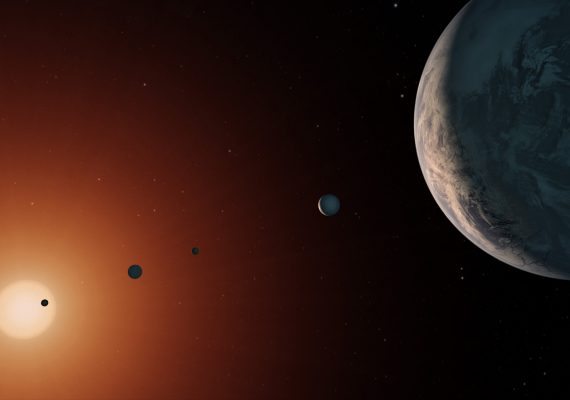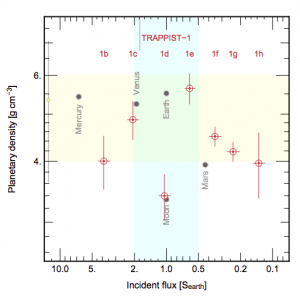
One year ago, I wrote an article about the remarkable discovery of the TRAPPIST-1 planetary system, a system of seven temperate terrestrial planets orbiting an ultra-cool red dwarf star. This was an enormous astronomical discovery because these low-mass stars are the most numerous ones in our galaxy, and the discovery of potentially habitable planets around one of them led many people to speculate about the existence of life there and elsewhere in our galaxy around similar stars.
This announcement also inspired a lot of additional studies by astronomers worldwide, who have used additional instruments and run complex models to better understand this planetary system and its potential for hosting life.
One year later, it seems to me that the time is right to give you an update on what we’ve learned about this planetary system, which is located only 41 light-years from Earth.
Better Understanding of the Planetary System
Between December 2016 and March 2017, additional data on TRAPPIST-1 were collected using the Kepler spacecraft in the K2 program. Kepler was designed to measure transits of exoplanets, but observations of TRAPPIST-1 were a huge challenge even for this remarkable planet-hunting spacecraft because TRAPPIST-1 is very faint in visible light. During its lifetime, astronomers have learned a lot about Kepler’s many capabilities, including better ways to reach the sensitivity necessary to detect the signatures of TRAPPIST-1-type transits (typically 0.1% the flux of the star). The authors of an article published in May 2017 in Nature were able to constrain the orbital period of the outermost planet, TRAPPIST-1h (P=18.766 days). Their work shows that the seven planets are, as suspected, in three-body resonances in a complex chain that suggests good stability over a very long period of time.
Keep in mind that we do not see the planets but detect only their shadow using the transit technique that gives us a good estimate of a planet’s size and its orbit. However, to truly understand the nature of a planet, we also need to determine its density, and hence its mass. In an effort to estimate mass in multiple systems, astronomers have used a technique called transit-timing variations (or TTV). This technique consists of measuring a small shift in the timing of a transit caused by gravitational interaction with the other planets in the system. Using a new algorithm and a complete set of data, including data from both TRAPPIST and K2, a team of scientists has significantly improved the density measurements of the TRAPPIST-1 planets, which range from 0.6 to 1.0 times the density of Earth, or a density measurement similar to what we see in the terrestrial planets in our solar system. If we also consider the amount of light we receive from these planets, TRAPPIST-1 e is probably the most Earth-like one in the system. A paper published in February 2018 also included a discussion of the interior of these planets and suggested that TRAPPIST-1 c and e have large rocky interiors and -b, -d, -f, -g should have thick atmospheres, oceans, or icy crusts.

To understand a planetary system, we need accurate information about its most massive object, its star. Stellar astronomers have improved their knowledge of TRAPPIST-1’s star and now estimate its age to be between 5 and 10 billion years, which makes it older than our sun. This estimate is based on various methods, including the study of its activity, its rotation rate, and its location in the Milky Way. Its mass has also been revised to 9% the mass of our sun, which slightly affects the distance of the planet from the host star.
While observing the TRAPPIST system, astronomers have also detected strong star- like flares (seen, for instance, toward the end of the K2 observations). UV monitoring by the Hubble Space Telescope and by XMM/Newton combined with modeling revealed that the inner planets may have lost a large amount of water, but the outermost ones probably retain most of theirs. The complexity of these outgassing models and interactions with the stellar wind, when combined with planetary masses, are key to understand the nature of TRAPPIST-1’s planets and their potential habitability.
Dynamicists, who represent another important astronomical subdiscipline, have also taken an interest in this complex system. With seven planets surrounding a low-mass star, one can legitimately wonder about system stability. Their models show us that the system can be stable over billions of years, which is outstanding news if you want life to flourish there.
New Experiments and Innovative Ideas
We now have unambiguous proof of the existence of the TRAPPIST-1 planets, and we know about their orbits, their size, and their mass, but a lot still remains to be learned before we can claim that they have liquid water on their surface, and we need to know far more than that before we can conclude that these planets might be habitable, or inhabited.
One of the key challenges to computing the surface temperature of a planet is the existence and composition of its atmosphere. The atmosphere can act like a blanket, warming up the planetary surface. Using the Hubble Space Telescope, astronomers have attempted to detect the presence of rich hydrogen-dominated atmospheres around TRAPPIST-1 planets d, e, f, and g. Multi-color transit events taken in the near-infrared have ruled out such an atmosphere for planets d, e, and f. A H2-dominated atmosphere would lead to high surface temperatures and pressures, which are incompatible with the presence of liquid water. This negative detection suggests that these planets could have an Earth-like atmosphere with a temperate surface climate, which is more good news if, like me, you’re interested in habitability.

If life appeared on one TRAPPIST-1 planet at a time when it was hospitable, what are the chances that it spread throughout the entire system? Two astronomers discussed this hypothesis in a short article published in June 2017 and used a simple model for lithopanspermia (the transfer of organisms in rocks from one planet to another either through interplanetary) to discover that the likelihood of that happening is orders of magnitude higher than for the Earth-to-Mars system. In compact TRAPPIST-1, the probability of impact is higher and the transit time between planets is shorter, which makes contamination among planets more likely. They concluded that the probably of abiogenesis (the appearance of life) is enhanced for TRAPPIST-1. Of course, this is pure speculation based on physical considerations that need to be backed up by observations, but it reinforced the importance of finding such compact mini-planetary systems elsewhere the galaxy.
Life can exist on moons as well as planets, and a moon can be a significant contributor to the presence of life because its sheer presence can stabilize the planet’s axis of rotation and create tidal pools that may be necessary for complex molecules to form and interact. No moons have been detected around the TRAPPIST-1 planets, even though the Spitzer observations were able to detect a moon as large as Earth’s. Theoretical study shows that the inner planets (-b to -e) are unlikely to have small moons because of the proximity of their star and other planets. We are not yet able to detect the presence of a small moon circling one of the outermost planets, and will not be able to detect one without using bigger telescopes in space and on the ground.
Induction heating is a process used on Earth to melt metal. It occurs when we change the magnetic field in a conducting medium, which then dissipates the energy through heat. Astronomers have known for a few years that M-type stars like TRAPPIST-1 have a strong magnetic field. A group of astronomers studied the effect of such a strong magnetic field on the interior of planets in a system tilted with respect to the magnetic field of their star. Assuming a planetary interior and composition similar to Earth, they determined that the three innermost planets (-b, -c, -d) should experience enhanced volcanic activity and outgassing, and in some extreme cases have developed a magma ocean with plate tectonics and large-scale earthquakes, comparable to Io, a satellite of Jupiter. Again, this result is extremely model-dependent since we don’t yet have a clear idea of the internal composition of those planets, which will directly affect the strength of the induction heating. However, if they are truly Earth-like in composition, they could be a hellish version of our own planet.
Other scientists have also discussed the existence of significant plate tectonics and intense earthquakes in this system due to tidal stress introduced by planet-to-star and planet-to-planet interactions. If the activity is right, some of the TRAPPIST-1 planets could indeed be similar to Earth with the equivalent of continental plates, ocean floors, and active volcanoes, but one day we will need to take a picture to confirm this.
What’s next?
I have summarized some of the latest articles published over the past two years about the wonderful TRAPPIST-1 system. This list is not exhaustive and I probably missed some interesting ideas and new hypotheses about this complex system.
But one thing is crystal-clear: My readings have left me (and a lot of other people) stoked about what we might find from additional observations with large ground-based telescopes, including an Extremely Large Telescope (like the TMT, ELT, or GMT), or the James Webb Space Telescope (JWST). Each of these facilities is needed to constrain our models and refine our understanding of this system. For instance, long-term monitoring of the system with these facilities will place further constraints on the presence of moons in the system. Using the accurate photometry made possible by JWST, astronomers hope to constrain planetary masses and orbits to a great accuracy, derive the composition of their atmospheres, construct crude temperature maps of all of the planets in the TRAPPIST-1 system.
After 2020, if everything goes well with JWST and if the space telescope provides the superb data that we expect, we might have a crude map of the TRAPPIST-1 planets, similar to the rough image of Pluto made with Hubble Space Telescope and later validated by the New Horizons Spacecraft.

In less than two decades, nearby planetary systems like TRAPPIST-1 will become our cosmic backyard, and if everything goes as planned with missions like TESS, PLATO, ARIEL, and JWST as well as the ELTs, we will soon learn the secrets of those exotic worlds which, I am convinced, will surprise us by their diversity, just as our own solar system has surprised us over the past two decades, surprises us today, and will surely continue to surprise us in the future.
Clear skies,
Franck M.
If you want to learn more about the TRAPPIST-1 system, check out some of those articles (all available for free on ArXiV).
Boss, Alan P., Alycia J. Weinberger, Sandra A. Keiser, Tri L. Astraatmadja, Guillem Anglada-Escude, and Ian B. Thompson. 2017. Astrometric Constraints on the Masses of Long-Period Gas Giant Planets in the TRAPPIST-1 Planetary System. The Astronomical Journal, Volume 154, Issue 3, article id. 103, 6 pp. (2017). 154. doi:10.3847/1538-3881/aa84b5.
Bourrier, V., J. de Wit, E. Bolmont, V. Stamenkovic, P. J. Wheatley, A. J. Burgasser, L. Delrez, et al. 2017. Temporal evolution of the high-energy irradiation and water content of TRAPPIST-1 exoplanets. The Astronomical Journal, Volume 154, Issue 3, article id. 121, 17 pp. (2017). 154. doi:10.3847/1538-3881/aa859c.
Burgasser, Adam J., and Eric E. Mamajek. 2017. On the Age of the TRAPPIST-1 System. The Astrophysical Journal, Volume 845, Issue 2, article id. 110, 10 pp. (2017). 845. doi:10.3847/1538-4357/aa7fea.
de Wit, J., H. R. Wakeford, N. Lewis, L. Delrez, M. Gillon, F. Selsis, J. Leconte, et al. 2018. Atmospheric reconnaissance of the habitable-zone Earth-sized planets orbiting TRAPPIST-1. Nature Astronomy, Volume 2, p. 214-219 2: 214–219. doi:10.1038/s41550-017-0374-z.
Grimm, S, B-O Demory, M Gillon, C Dorn, E Agol, A Burdanov, L Delrez, et al. 2018. The nature of the TRAPPIST-1 exoplanets. Astronomy & Astrophysics. doi:10.1051/0004-6361/201732233.
Kane, Stephen R., and Stephen R. 2017. Worlds Without Moons: Exomoon Constraints for Compact Planetary Systems. The Astrophysical Journal Letters, Volume 839, Issue 2, article id. L19, 4 pp. (2017). 839. doi:10.3847/2041-8213/aa6bf2.
Kislyakova, K. G., L. Noack, C. P. Johnstone, V. V. Zaitsev, L. Fossati, H. Lammer, M. L. Khodachenko, P. Odert, and M. Guedel. 2017. Magma oceans and enhanced volcanism on TRAPPIST-1 planets due to induction heating. Nature Astronomy, Vol. 1, p. 878-885 (2017) 1: 878–885. doi:10.1038/s41550-017-0284-0.
Lingam, Manasvi, and Abraham Loeb. 2017. Enhanced interplanetary panspermia in the TRAPPIST-1 system. Proceedings of the National Academy of Sciences, vol. 114, issue 26, pp.6689-6693 114: 6689–6693. doi:10.1073/pnas.1703517114.
Luger, Rodrigo, Marko Sestovic, Ethan Kruse, Simon L. Grimm, Brice-Olivier Demory, Eric Agol, Emeline Bolmont, et al. 2017. A seven-planet resonant chain in TRAPPIST-1. Nature Astronomy, Volume 1, id. 0129 (2017). 1. doi:10.1038/s41550-017-0129.
Tamayo, Daniel, Hanno Rein, Cristobal Petrovich, and Norman Murray. 2017. Convergent Migration Renders TRAPPIST-1 Long-lived. The Astrophysical Journal Letters, Volume 840, Issue 2, article id. L19, 6 pp. (2017). 840. doi:10.3847/2041-8213/aa70ea.
Van Grootel, Valerie, Catarina S. Fernandes, Michaël Gillon, Emmanuel Jehin, Jean Manfroid, Richard Scuflaire, Adam J. Burgasser, et al. 2017. Stellar parameters for TRAPPIST-1. The Astrophysical Journal, Volume 853, Issue 1, article id. 30, 7 pp. (2018). 853. doi:10.3847/1538-4357/aaa023.
Zanazzi, J. J., and Amaury Triaud. 2017. Initiation of Plate Tectonics on Exoplanets with Significant Tidal Stress. eprint arXiv:1711.09898.

